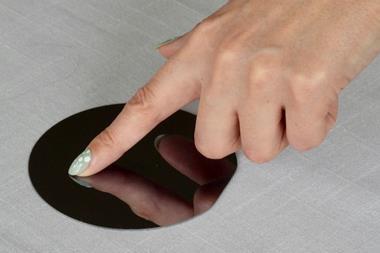A new study shows humans can differentiate between two surfaces that are identical but for a single atom substitution – one is coated with alkyl silanes, the other with amino silanes.
Chemistry World reported a few years ago that humans can detect the difference in surface energy between a hydrophobic monolayer and a hydrophilic plasma-oxidised surface. Now, Charles Dhong and his team at the University of Delaware, US, have decided to find out more about what surface chemical changes humans can perceive. To do this they made surfaces consisting of silane monolayers before making slight changes to the monolayer chains, like substituting a carbon for a nitrogen atom and changing the chain length. They created surfaces so smooth that humans could not perceive slight changes in roughness between them, meaning it was the surface chemistry allowing them to distinguish the surfaces as different. People participating in the tests were asked to pick the odd-one-out from three samples. The test subjects could differentiate between surfaces containing silanes with an alkyl chain of four carbon atoms and surfaces containing silanes with the final carbon replaced by an amine group.
The subjects are not directly sensing the chemical difference, as the mechanoreceptors in fingers are not sensitive to chemicals, like the receptors used in smell and taste. However, the differences in chemistry do give rise to differences in friction, which humans can detect. Dhong’s team says the mechanism of tactile contrast likely originates from a difference in monolayer ordering. The researchers use a Hurst exponent, which in this case was used as a measure of the order or disorder of the silane monolayer, to predict which surfaces could be distinguished. The surface with the amine group is more ordered due to hydrogen bonding, and this increased order decreases friction.
Test subjects could also distinguish a surface covered in carbon chains that were five carbons long from ones that were eight carbons long as the longer chains were more ordered due to a phase transition. Using disorder versus order to predict human performance was more reliable than using surface energy, and the scientists even found that two surfaces with almost identical surface energies could be distinguished.
A note of caution, however: samples varying by a single-atom substitution were not always identifiable. Substituting an amine group for carbon on a longer chain was insufficient for the human subjects to discriminate between the surfaces. This substitution didn’t cause a change in ordering, and therefore didn’t change the friction enough to be detectable.

The team also made a mechanical model finger from polydimethylsiloxane (PDMS), which was treated to have a similar hydrophilicity to human skin, to predict which surfaces would be distinguishable by a real human finger. Inside the PDMS finger was an acrylic bone that provided rigidity and mimicked the distal phalange of a human finger. The scientists measured friction whilst sliding the mock finger across each surface as a function of velocity and force. Comparing the friction of different surfaces gave a prediction of how easy it would be for a person to tell them apart. Surfaces that were predicted to be differentiable under one combination of force and velocity may not be under a different force–velocity combination.
Cara Nunez, an expert in human haptic perception at Stanford University, US, says ‘this is exciting preliminary work as it demonstrates the acuity of human touch with respect to chemistry and presents the chemical composition of the surface as an additional degree of freedom that researchers and engineers can manipulate to design haptic interfaces.’
‘Haptics researchers focus primarily on physical components of touch, such as mechanical deformation, whereas this work explores how chemical changes at the atomic level also play a role in how we identify and perceive interactions with objects,’ adds Nunez.
Dhong’s team says their work could help researchers discover new materials for haptics research and result in better haptic tools. Fine tuning surface chemistry could be a simple way to produce new tactile experiences for users of virtual reality and when using surgical dummies in medical training.












No comments yet